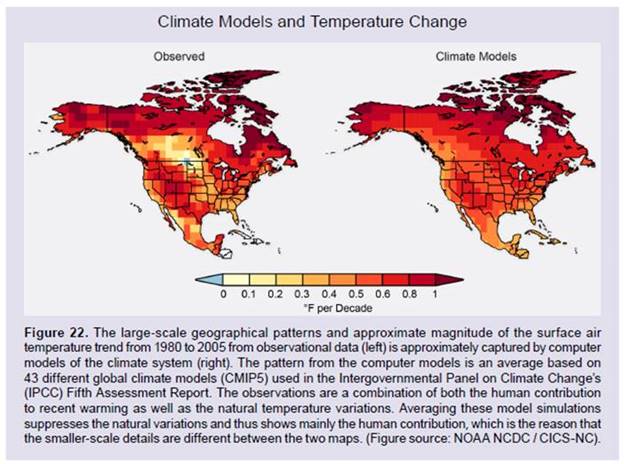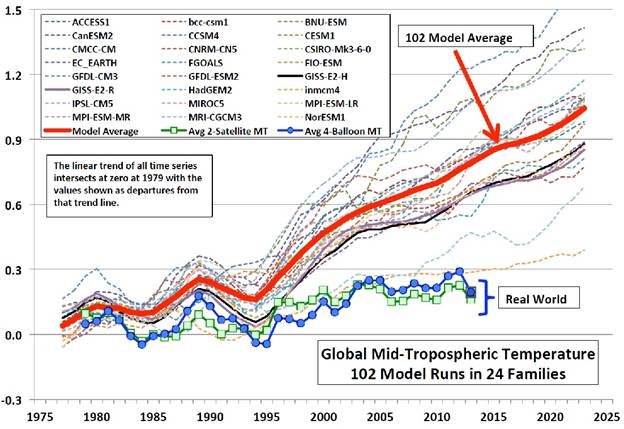It’s become almost common knowledge that global climate computer models used to project future temperatures based on assumptions about greenhouse gas emissions miss the mark. So common that much of the American public even knows it.
But the National Climate Assessment released May 6, 2014, uses them anyway to predict future climate changes and their impact for the United States.
How does it defend that? By claiming that the models “do a good job at reproducing the broad features of the present climate and changes in climate, including the significant warming that has occurred over the last 50 years” (p. 809, FAQ-R).
How does it substantiate that claim? With this graphic:
[CLICK ON PICTURE FOR MORE RESOLUTION]
There are three big problems.
First, the claim was that the models “do a good job at reproducing the broad features of the present climate and changes in climate, including the significant warming that has occurred over the last 50 years.” But the graphic shows only 25 years, 1980–2005.
Second, as Dr. Roy Spencer, Principal Research Scientist in climatology at the University of Alabama, puts it, global climate models … are known to have essentially zero skill for regional (e.g. U.S.) predictions.” This means the moderately good fit between observed and modeled temperatures in the NCA’s graphic is likely to be mere coincidence. This is all the more likely since the globe as a whole was warming from 1980 through 1997 (excluding the anomalous 1998, extra warm because of an exceptionally strong El Niño).
Third, although not explicitly stated, the claim is that global climate models “do a good job.” But the graphic shows only North America. Global surface is 21 times North American. If the whole globe is warming, it’s likely that particular regions are warming; but the reverse isn’t true. Showing, then, that North America was warming (and only for half the period in question) doesn’t imply that the models’ predictions of warming for the whole world are reliable.
So how do the models do for the whole world? Not well, as this graphic by Dr. John Christy, Distinguished Professor of Atmospheric Science and Director of the Earth System Science Center at the University of Alabama in Huntsville, shows.
[CLICK ON PICTURE FOR MORE RESOLUTION]
In short, to justify its claim that the models “do a good job” for the world over a 50-year period, the National Climate Assessment depicts data for less than a twentieth of the world over a half the time. In other words, it cherry picks both chronologically and geographically.
As if that weren’t bad enough, it then uses the global climate models, which have “essentially zero skill for regional (e.g. U.S.) predictions,” to predict climate not just for the United States as a whole (for which they have “essentially zero skill”) but for nine sub-regions (for which therefore they have even less skill). Result: Its predictions are not credible.
————————————–
E. Calvin Beisner, Ph.D., is Founder and National Spokesman of The Cornwall Alliance for the Stewardship of Creation, of which Dr. Roy W. Spencer is a Senior Fellow.
Source: http://www.masterresource.org/2014/05/national-climate-assessment-indefensible/
electrical supply company electrical service contractor electrical estimating


No comments:
Post a Comment